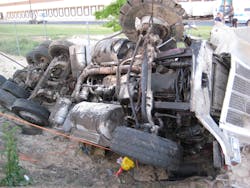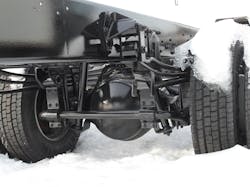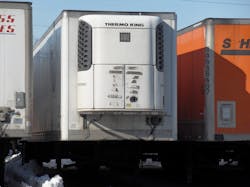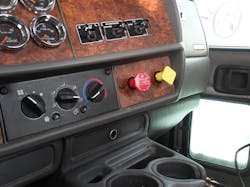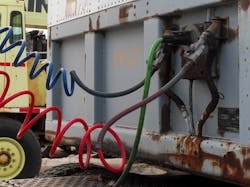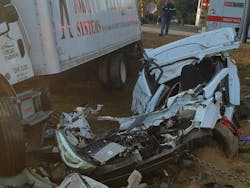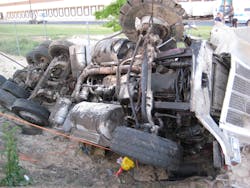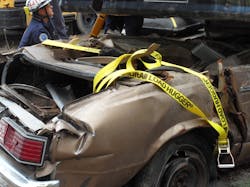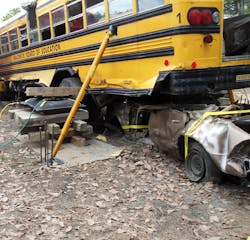Truckin’: Commercial Vehicle Extrication & Rescue
When you pick your next item off of the store shelf, odds are particularly good that it got there by a commercial vehicle. Some 3 million interstate commercial vehicles typically travel across the United States per year. Multiple millions of tons of freight are moved. With this much activity, so comes the increased potential of serious accidents that involve these vehicles.
In 2017 (the most recent year for which data are available), 507,000 accidents that involved at least one commercial vehicle occurred; 116,000 of them resulted in injuries; 4,455 brought fatalities. For responders who deal with an incident that involves a commercial vehicle, preparations are the key to efficiency and success. These vehicles pose different concerns on scene, and some are particularly significant.
This area of expertise requires a bit more capability than just bending and ripping metal; many times, these incidents require a strong background in lifting and moving objects. Knowing the lifting and displacement capabilities of your equipment and having adequate resources at your disposal to displace heavy loads are crucial. After all, these vehicles dwarf common passenger vehicles. However, rescuers can’t sit by idly, waiting for resources to arrive. They must be capable of moving these objects quickly with equipment that is on the arriving apparatus.Commercial vehicle hazards
There are eight classes of commercial vehicles based on gross vehicle weight ratings (GVWR). For our use, it is easier to break them into three broad categories—light duty: 6,000–14,000 lb. GVWR; medium duty: 14,001–26,000 lb. GVWR; and heavy duty: more than 26,000 lb. GVWR.
There are few similarities between each truck, because many of them are custom-built for usage as ordered. For example, although spring suspension systems are the standard in the industry, there are other types, including cushion suspension, Camelback spring, air bag and combination spring/air bag. That said, each suspension system must be identified for stabilizing points and displacement concerns to control vehicle travel during displacement.
One of the primary hazards that rescuers encounter is the electrical systems. The most common is the 12-volt system, but it looks much different than the automobile 12-volt system. Commercial vehicles utilize multiple batteries. Batteries are wired either in series or parallel. Series wiring sends current through each battery in a single direction. In this case, disconnecting the negative post that’s closest to the frame breaks the loop and shuts down the electrical system. Parallel wiring sends current through each battery concurrently. The rescuer must disconnect all of the negative connections to power down the system. Many hybrid-powered trucks utilize a 60-volt hybrid drive unit in conjunction with the vehicle’s transmission. The unit is powered by a hybrid converter system and can involve more than 300 volts. Most important in all of this, battery location varies from vehicle to vehicle. Additionally, be wary of secondary equipment—for example, a secondary voltage system, which must be secured as well as the main electrical system.
The primary fuel systems for these vehicles are diesel fuel, but other types are in service.Diesel fuel is popular because: it provides an efficient “burn” in the cylinder when it is atomized; it removes heat from the fuel-system components; it acts as lubrication for fuel-injection parts; and its viscosity limits gelling, which aids in flow in colder weather.
Fuel loads for these vehicles don’t sit only in saddle tanks that are on the sides of the vehicle. Based upon application, there might be other powered components on the vehicle. For example, tractor trailers that haul perishable goods carry them in refrigerated trailers, or “reefer units.” These units have a refrigerant system that’s powered by a second engine, and the fuel tank will be found either on top or underneath the trailer.
Be sure to shut down the vehicle, keep the fuel shut-off set in the “no-fuel” position and close all shut-off valves on all fuel tanks.Hydraulic drive systems operate a truck’s functional equipment. Hydraulics can be found operating components on trash-collection vehicles, cement-delivery vehicles and lift gates, among others. Pressure that’s in these systems can range from 25 psi at idle to upward of 2,200 psi. It is critical that hydraulic systems are secured and stabilized prior to extrication operations. Be sure that the vehicle power is shut down; some of the power for these systems can come from the tractor. Next, block and stabilize the components in place. Don’t jar the system or attempt to move the component. Furthermore, many rescuers won’t be familiar with a specific hydraulic component’s controls; trying to figure it out on scene has resulted in further injury to the patient and injury to rescuers. Now, shut down the hydraulic feed to the system. A main shut-off valve should be located somewhere in proximity to the oil tank. After that, identify any hydraulic components and piping in relation to the extrication. It is particularly important for rescuers not to cut through any piping during the extrication. Failure of the system might occur, which could result in catastrophic movement of a component, injury from high-pressure atomized oil exposure or crush injury by being struck with overhead supported loads.
Operational considerations
Upon receiving a dispatch to an extrication that involves a large commercial vehicle, get the right resources responding as soon as possible. Many companies utilize an automatic aid system that will provide for notification and dispatch of multiple heavy-duty rescue companies.
Make contact with a response-capable heavy-wrecker company; in the event of an under-ride or rollover incident that involves passenger vehicles and commercial vehicles, a heavy-duty wrecker that has a rotating boom assembly is advantageous.
Coordinate these resources with local law enforcement; many police departments have these resources categorized and “on standby” to respond to major roadways.
The potential for an increased hazardous material release risk will be significant. Most times when dealing with passenger-vehicle extrications, the fuel system remains somewhat intact; there might be a leaking fuel line, but, for the most part, it can be controlled with minimal additional resources. Commercial trucks, however, pose a larger risk.
Another major consideration on scene is the vehicle cargo: namely, what issues will the cargo pose if it is released? Cargo usually is loaded for equal distribution on the suspension of the vehicle, and if it breaks loose, the cargo might need to be lifted, shored or tunneled through to get to the victim. In terms of lifting, the cargo’s capability to be controlled is significant. Liquid cargo on a vehicle will create inertia while it’s in motion, which will need to be controlled throughout moving the vehicle.
Most large tractor trailers can carry upward of 300 gallons of fuel in dual saddle tanks that are directly under the cab. Not only is this a potential combustibility issue, but, unless the material is contained and diverted, patient access might require rescuers to work directly over the product when it is released onto the roadway. Have the resources needed to handle this issue quickly, so the extrication can be set into action.
Upon arrival, after scene safety has been secured, there is one critical question that must be answered: Where is the victim(s)? Victim location will define what type of operation and what additional resources will be needed. In the event that the victim is in the cab of the commercial vehicle, consider this: Rescuers will be working above ground level. Where will they operate from? You don’t want members to operate from the thin metal step treads that are mounted on the vehicles’ fuel tanks. This can cause injuries from slips and falls. Working with the equipment on the responding apparatus, many companies will have to set crib stacks and ladders for makeshift “scaffolds” just for crews to work. Instead, think about requesting a flatbed wrecker to the scene. This would serve as a sturdy platform for the rescue crews.
Secondly, stabilization needs will be difficult. Frame rails for commercial vehicles are much higher than what are found on passenger vehicles. Larger cribbing might be needed, not only for increased weight support but to provide for height gain in crib stacks. Furthermore, the cab of the truck needs additional cribbing from the frame rails to the underside of the cab. Not only do these vehicles have body-mount assemblies, but many are spring-loaded or pneumatically charged to adjust the ride for the operator. Also, the cab “load” must be directed to the ground through the frame rails.
Many heavy-truck cab components are considerably heavier than what you might find in a passenger vehicle. These components will have to be fatigued, removed and lowered safely after they are displaced.
Once victims are disentangled and packaged for removal, rescuers might accept victims over their heads to lower them onto a stretcher. The mere act of removing a somewhat larger victim will require a significant amount of manpower. Have the adequate personnel on scene.
Once the victim location and the plan to remove them are identified, the next point to consider is: Is there a need to displace or move the vehicle(s)? When we must lift or move a vehicle, we must know the weight of what we will be moving. A quick way to get a rough idea of the potential weight of the vehicle involves counting the axles and adding the weight ratings together. A good rule of thumb for axle weight is: steering axle that has thin profile tires = 12,000 lb./axle rating; steering axle that has wide profile (flotation) tires = 20,000 lb./axle rating; drive axle that is on a tractor/truck = 25,000 lb./axle rating; and tag axle/trailer axle = 20,000 lb./axle rating. (Note: These are averaged assumptions, based on manufacturers’ GVWR; some might be rated for more, but it will get you started.)
Using the above numbers, consider a twin-drive axle dump truck that is equipped with a tag axle and wide profile tires on the steering axle. Based on the estimations above, the potential capacity of that truck and contents can weigh about 80,000 lbs.
What do you have in your resources that can lift/move/haul/hold these loads? Finding an answer to this question on scene isn’t a good plan.
Don’t forget the properties of the cargo. Solids, liquids and gases react differently when they are displaced. Some container trucks must be off-loaded prior to lifting, because the container might fail when it’s loaded eccentrically. Be sure to check with experts before trying something that might end in disaster.
Once the lift is done, it might be necessary to separate the vehicles. This might require dragging the passenger vehicle from underneath the commercial vehicle. Although this approach is a bit controversial, let us consider two extremely critical points to this argument:
Working underneath any suspended load isn’t recommended. If resources that are on scene can not only lift but stabilize the load in such a way that crews will be protected while they work on the smaller vehicle, then go ahead and begin patient care. However, it has been my experience that isn’t possible very often.
If rescuers can’t access the patient, they can’t provide patient care. Having discussed this position with a few trauma physicians, most of them echo a common fact about patient care: They can fix a lot of things on a person, but they can’t fix dead. That not only stands to reason for the patient, but for the rescuer as well.
Remember this point: It might be necessary to alter techniques to achieve the needed room for disentanglement. A proficient rescuer can utilize a cache of equipment in multiple ways to achieve the necessary results, just by modifying position of applied force with a tool or technique. Don’t operate with “functional fixation.” These incidents require some detailed analysis and thought to come up with a solution, so be flexible.
Prep smart
Extrications that involve commercial vehicles can prove to be problematic for even the best-trained rescue companies. Limited access, unstable cargo and heavier components to displace can prove difficult for rescue teams to overcome. Continued training on extrication skills and techniques, coupled with updating vehicle knowledge in terms of both passenger and commercial vehicles, can provide critical intelligence for successful outcomes. Preparation and education are critical in all aspects of rescue, and this field is no different.
About the Author

Michael Daley
MICHAEL DALEY, who is a Firehouse contributing editor, recently retired as a 37-year veteran who served as a captain and department training officer in Monroe Township, NJ. He is a staff instructor at multiple New Jersey fire academies and is an adjunct professor in the Fire Science Program at Middlesex County College. Daley is a nationally known instructor who has presented at multiple conferences, including Firehouse Expo and Firehouse World. His education includes accreditations as a Chief Training Officer and a Fire Investigator, and he completed the Craftsman Level of education with Project Kill the Flashover. Daley is a member of the Institution of Fire Engineers and a FEMA Instructor and Rescue Officer with NJ Urban Search and Rescue Task Force 1. He operates Fire Service Performance Concepts, which is a training and research firm that delivers and develops training courses in many fire service competencies.
